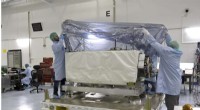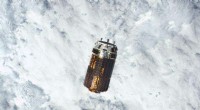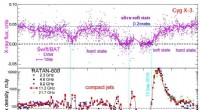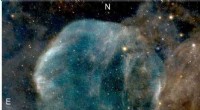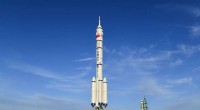
Wetenschap
Hoe NASA's Webb-telescoop de erfenis van Spitzers zal voortzetten
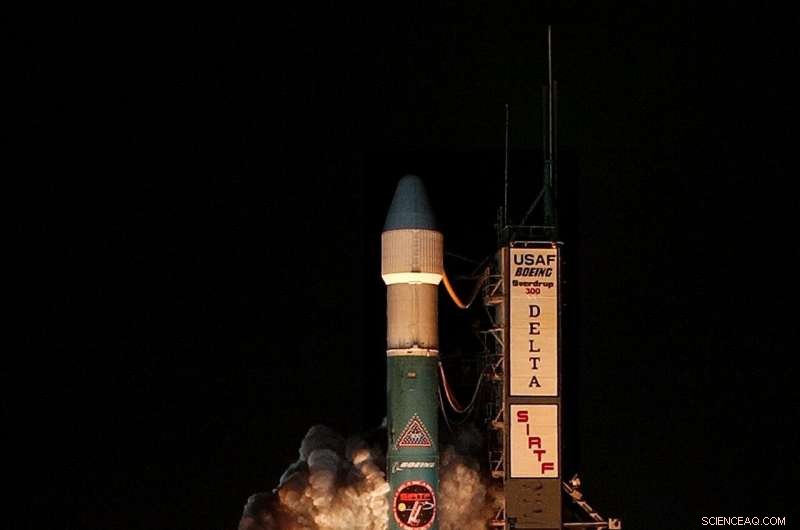
NASA's Spitzer-ruimtetelescoop, toen bekend als de Space Infrared Telescope Facility, lanceert maandag vanaf het Cape Canaveral Air Force Station in Florida, 25 augustus 2003. Krediet:NASA
Als een venster naar het universum sluit, een andere zal openen met een nog beter zicht. Sommige van dezelfde planeten, sterren en sterrenstelsels die we voor het eerst door het eerste venster zagen, zullen in nog scherper detail verschijnen in het venster dat binnenkort wordt geopend.
NASA's Spitzer Space Telescope beëindigt zijn missie op 30 januari, 2020, na meer dan 16 buitengewone jaren van verkenning. De telescoop heeft veel ontdekkingen gedaan die de verbeelding van zijn ontwerpers te boven gaan, zoals planeten buiten ons zonnestelsel, exoplaneten genoemd, en sterrenstelsels die zich dicht bij het begin van het heelal hebben gevormd. Veel van Spitzers doorbraken zullen nauwkeuriger worden bestudeerd met de aanstaande James Webb Space Telescope, die naar verwachting in 2021 van start gaat.
"We hebben veel nieuwe vragen over het universum vanwege Spitzer, " zei Michael Werner, Spitzer-projectwetenschapper bij NASA's Jet Propulsion Laboratory in Pasadena, Californië. "Het is erg verheugend om te weten dat er zo'n krachtige reeks mogelijkheden komt om op te volgen wat we met Spitzer hebben kunnen starten."
Zowel Webb als Spitzer zijn gespecialiseerd in infrarood licht, die onzichtbaar is voor menselijke ogen. Maar met zijn gigantische goudgecoate berylliumspiegel en negen nieuwe technologieën, Webb is ongeveer 1, 000 keer krachtiger. De aanstaande telescoop zal de wetenschappelijke bevindingen van Spitzer naar nieuwe grenzen kunnen duwen, van het identificeren van chemicaliën in exoplaneetatmosferen tot het lokaliseren van enkele van de eerste sterrenstelsels die zich na de oerknal hebben gevormd.
Voorbij zijn ontdekkingen, Spitzer is ook een pionier voor Webb als het gaat om het bedienen van een dergelijke telescoop. Om infrarood licht met hoge gevoeligheid te meten, een telescoop moet erg koud zijn. Spitzer heeft ingenieurs laten zien hoe een infrarood-observatorium zich gedraagt in de uitgestrektheid van de ruimte en met welke temperaturen missieplanners voor Webb zouden moeten worstelen.
"Het hebben van een enorme telescoop in de ruimte is moeilijk. Maar het hebben van een enorme telescoop die koud is, is veel moeilijker, " zei Amber Straugn, plaatsvervangend projectwetenschapper voor James Webb Space Telescope Science Communications. "Spitzer heeft ons geholpen te leren hoe we een zeer koude telescoop in de ruimte beter kunnen bedienen."
Met meer dan 8, 700 wetenschappelijke artikelen gepubliceerd op basis van de ontdekkingen van Spitzer, de telescoop is een enorme aanwinst geweest voor astronomen in verschillende disciplines. Veel van deze verleidelijke resultaten zijn rijp om opnieuw te bekijken met een krachtigere telescoop, en Webb staat klaar om ze al vroeg in zijn missie te onderzoeken. Hier is een greep uit de prestaties van Spitzer waarop Webb zal voortbouwen.
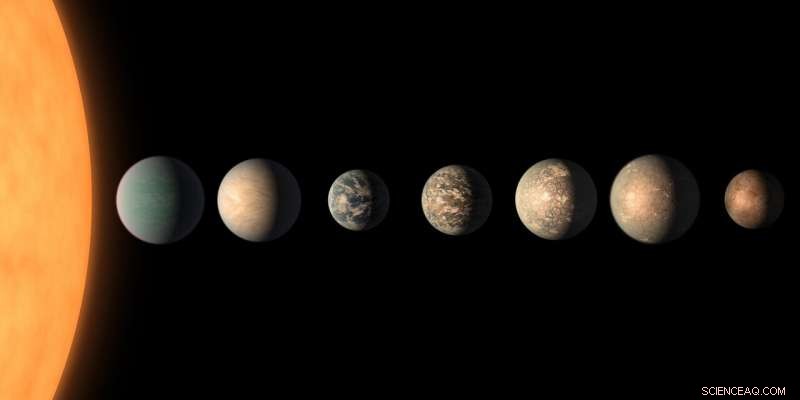
Het concept van deze kunstenaar laat zien hoe het planetaire systeem TRAPPIST-1 eruit kan zien, op basis van beschikbare gegevens over de diameters van de planeten, massa's en afstanden van de gastster. De Spitzer Space Telescope bevestigde de aanwezigheid van twee planeten ter grootte van de aarde in het systeem voordat hij er nog vijf ontdekte. Krediet:NASA/JPL-Caltech
exoplaneten
Een van Spitzers meest verbluffende ontdekkingen was dat er niet slechts drie, maar zeven rotsachtige planeten ter grootte van de aarde in een baan om een kleine, zwakke ster genaamd TRAPPIST-1. TRAPPIST-1 is een van de best bestudeerde planetenstelsels, afgezien van het onze, maar er valt nog veel meer over te leren.
De vierde planeet vanaf de ster, TRAPPIST-1e is vooral interessant omdat het een dichtheid en oppervlaktezwaartekracht heeft die erg lijkt op die van de aarde en genoeg stellaire straling ontvangt om temperaturen te hebben die vriendelijk genoeg zijn voor vloeibaar water. Webb zal deze planeet observeren om een beter idee te krijgen of de planeet een atmosfeer heeft en, als, wat zijn chemie is.
De aanwezigheid van moleculen zoals koolstofdioxide, dominant op Mars en Venus, zou implicaties hebben voor de vraag of een planeet vloeibaar water en andere bewoonbare omstandigheden zou kunnen hebben. Webb zal atmosferisch water kunnen detecteren, te. Aanvullend, Webb zoekt naar warmte afkomstig van TRAPPIST-1b, de planeet die het dichtst bij zijn ster staat.
"De diversiteit aan sferen rond terrestrische werelden gaat waarschijnlijk onze wildste verbeelding te boven, " zei Nikola Lewis, assistent-professor astronomie aan de Cornell University in Ithaca, New York. "Het zal erg nuttig zijn om informatie te krijgen over lucht op deze planeten."
WASP-18b is een andere intrigerende planeet die Spitzer heeft onderzocht en die Webb in het begin van de missie verder zal onderzoeken. Deze gasreus, met 10 keer de massa van Jupiter, bevindt zich zeer dicht bij zijn ster, het voltooien van een baan om de 23 uur. Vanwege de hoge temperatuur - maar liefst 4, 800 graden Fahrenheit (2, 650 graden Celsius) - en groot formaat, het staat bekend als een 'hete Jupiter'. Met behulp van gegevens van Spitzer en Hubble, astronomers figured out in 2017 that this planet has a lot of carbon monoxide in its upper atmosphere and little water vapor. This planet is particularly interesting because it's so close to its star that it's in danger of being torn apart completely, and it may not survive another million years. Astronomers are interested in using Webb to look at the processes happening in this planet's atmosphere, which will provide insights into hot Jupiters in general.
Spitzer has also delivered unprecedented weather reports for exoplanets. In 2007, it made the first-ever map of the surface of an exoplanet, the hot Jupiter HD 189733b, showing its temperature variations and cloud tops. Recenter, in 2016, Spitzer highlighted the climate patterns of 55 Cancri e, a possibly lava-covered world more than twice the size of Earth. But maps from Spitzer have given scientists a lot to think about as they look to further investigations with Webb.
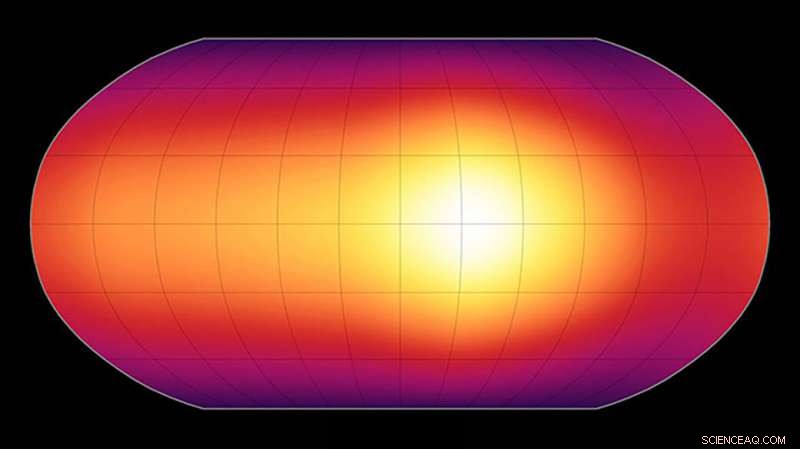
This is the first-ever map of the surface of an exoplanet, or a planet beyond our solar system. The map, which shows temperature variations across the cloudy tops of a gas giant called HD 189733b, is made from infrared data taken by NASA's Spitzer Space Telescope. Credit:NASA/JPL-Caltech/Harvard-Smithsonian CfA
Other Exotic Objects
Spitzer has also made strides in identifying and characterizing brown dwarfs. A brown dwarf is larger than a planet but less massive than a star, and while stars generate their own energy by fusing hydrogen, brown dwarfs do not. Spitzer has been able to look at the clouds in brown dwarf atmospheres and observe how they move and change shape with time. Webb will also examine brown dwarf cloud properties and delve deeper into the physics of these mysterious objects.
Infrared light has also been revolutionary for looking at disks of gas and dust orbiting stars, and both Spitzer and Webb are sensitive to the infrared glow of this material. Disks that Spitzer has studied contain the raw materials for making planets and may represent the state of our solar system before Earth and its neighbors formed. Spitzer has seen particles around young stars beginning to transform into the seeds of small planetary bodies, and that some disks have materials similar to those seen in comets in our solar system. Webb can look at the same disks and find out even more about the planetary formation process.
Oodles of Galaxies
As light travels from distant objects to Earth, its wavelength becomes longer because the universe is expanding and those objects are moving farther from us. Just like the sound of a siren seems to lower in pitch as an ambulance drives away, light from distant galaxies also lowers in frequency, a phenomenon called "redshift." That means stars that give off visible light in the early universe will appear in the infrared by the time their light reaches Earth. This makes infrared light an especially powerful tool for exploring the universe's ancient past.
Pinpointing hundreds of billions of galaxies is currently impossible, but Spitzer has made large galaxy catalogs that represent different slices of the universe, containing some of the most distant galaxies we know. The large survey areas of Spitzer and Hubble Space Telescope have allowed astronomers to efficiently look for objects that could be studied in further detail with Webb.
Bijvoorbeeld, Spitzer, together with Hubble, took an image of a galaxy called GN-z11, which holds the record for most distant galaxy measured yet. It is a relic from when the universe was only 400 million years old, just 3% of its current age and less than 10% of its size today.
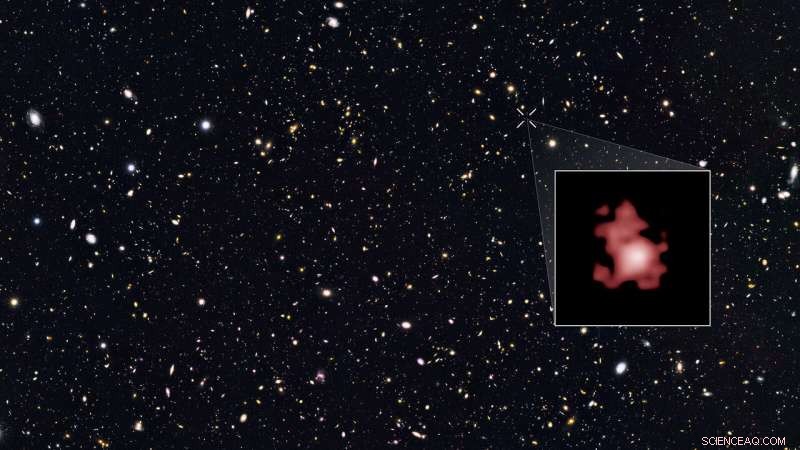
This is the first-ever map of the surface of an exoplanet, or a planet beyond our solar system. The map, which shows temperature variations across the cloudy tops of a gas giant called HD 189733b, is made from infrared data taken by NASA's Spitzer Space Telescope. Credit:NASA/JPL-Caltech/Harvard-Smithsonian CfA
"Spitzer surveyed thousands of galaxies, mapped the Milky Way and performed other groundbreaking feats by looking at large areas of the sky, " said Sean Carey, manager of the Spitzer Science Center at Caltech/IPAC in Pasadena, Californië. "Webb won't have this capability, but it will revisit some of the most interesting targets in the Spitzer surveys to reveal them in amazing clarity."
What's more, Webb's higher sensitivity will allow the telescope to look for galaxies dating back even earlier in the universe. And questions still abound about these distant galaxies:Are there a lot of stars forming in them or relatively few? Are they rich in gas or poor? Are there black holes at their centers, and how do those black holes interact with stars? En, scientists have pondered a chicken-and-egg problem for decades about which came first:the black hole or the surrounding galaxy?
"We'll be able to see some of the earliest galaxies to form in the universe that we've never seen before, " said Straughn.
Closer to home, Spitzer also studied many examples of a mysterious kind of galaxy called a luminous infrared galaxy, or LIRG. Such galaxies are generating tens to hundreds of times more energy per second than a typical galaxy, and most of that energy takes the form of far-infrared light. Scientists have used Spitzer to study LIRGs and learn about star formation and the growth of black holes during periods of rapid evolution when galaxies collide and merge. Such collisions were even more common 6 billion to 10 billion years ago and influenced the evolution of the universe as we know it.
"Webb will take inspiration from Spitzer and examine a variety of nearby and distant LIRGs to learn more about the role of galactic mergers, bursts of star formation and the growth of supermassive black holes in galactic evolution over cosmic time, " said Lee Armus of Caltech, who will lead a LIRG observing program for Webb.
Into the Infrared Unknown
For more than 16 years, Spitzer mapped out many of the most pressing questions in infrared astronomy. Now it's up to Webb to revisit them with sharper vision, through the grandest window yet to the cosmos.
 De kosten van eiwitpolymeergeneesmiddelen verlagen
De kosten van eiwitpolymeergeneesmiddelen verlagen Nieuwe zijden materialen kunnen kreuken in gedetailleerde patronen, dan ontkreuken om opnieuw te worden afgedrukt
Nieuwe zijden materialen kunnen kreuken in gedetailleerde patronen, dan ontkreuken om opnieuw te worden afgedrukt Smartphone-sensor kan vuil water detecteren
Smartphone-sensor kan vuil water detecteren Nieuw roodverschuivingsmechanisme van Ce3+ emissie in Ce
Nieuw roodverschuivingsmechanisme van Ce3+ emissie in Ce Blauwdrukken voor geneesmiddelen tegen kanker ontdekt in bacteriële genomen
Blauwdrukken voor geneesmiddelen tegen kanker ontdekt in bacteriële genomen
 Is de opwarming van de aarde gestopt? De kraan van inkomende energie kan niet worden uitgeschakeld
Is de opwarming van de aarde gestopt? De kraan van inkomende energie kan niet worden uitgeschakeld Hogesnelheidstrein aan de oostkust van Australië zou de uitstoot tot 36 jaar verhogen
Hogesnelheidstrein aan de oostkust van Australië zou de uitstoot tot 36 jaar verhogen Bermsloten zijn effectief bij het verwijderen van stikstof
Bermsloten zijn effectief bij het verwijderen van stikstof VS eindigen groot, verkoop van oerhout in het bos van Alaska
VS eindigen groot, verkoop van oerhout in het bos van Alaska Weerbaarheid herzien in het licht van klimaatverandering
Weerbaarheid herzien in het licht van klimaatverandering
Hoofdlijnen
- Maleisië redt 140 schubdieren van vermoedelijke smokkelaars
- Een gemakkelijke manier om het skelet te onthouden
- Wat is Feedback-inhibitie en waarom is het belangrijk bij het reguleren van de enzymactiviteit?
- Batesiaanse mimiek:hoe copycats zichzelf beschermen
- Een flitsende gele keelzanger? Daar zijn genen voor
- Wat is het verschil tussen hardhout en zachthout?
- Grootte doet er niet toe - althans voor hamerhaaien en zwemprestaties
- Het verschil tussen de genoom-DNA-extractie tussen dieren en planten
- Onverwachte bevinding in de energiecentrale van cellen
 Pandemische drones:handig voor het afdwingen van sociale afstand, of voor het creëren van een politiestaat?
Pandemische drones:handig voor het afdwingen van sociale afstand, of voor het creëren van een politiestaat? Overeenkomsten en verschillen tussen kikkers en padden
Overeenkomsten en verschillen tussen kikkers en padden  Google zet zich schrap voor enorme EU-boete over Android
Google zet zich schrap voor enorme EU-boete over Android Decimalen plotten
Decimalen plotten Lichamen van de mens en zijn slaaf opgegraven uit de as in Pompeii
Lichamen van de mens en zijn slaaf opgegraven uit de as in Pompeii Scherp smakende substantie in gember vermindert slechte adem
Scherp smakende substantie in gember vermindert slechte adem Combinatie van dennengeur en ozon als superbron van fijnstofemissies
Combinatie van dennengeur en ozon als superbron van fijnstofemissies NASA legt de laatste buiging van Kai-Taks in tropische depressie vast
NASA legt de laatste buiging van Kai-Taks in tropische depressie vast
- Elektronica
- Biologie
- Zonsverduistering
- Wiskunde
- French | Italian | Spanish | Portuguese | Swedish | German | Dutch | Danish | Norway |

-
Wetenschap © https://nl.scienceaq.com

